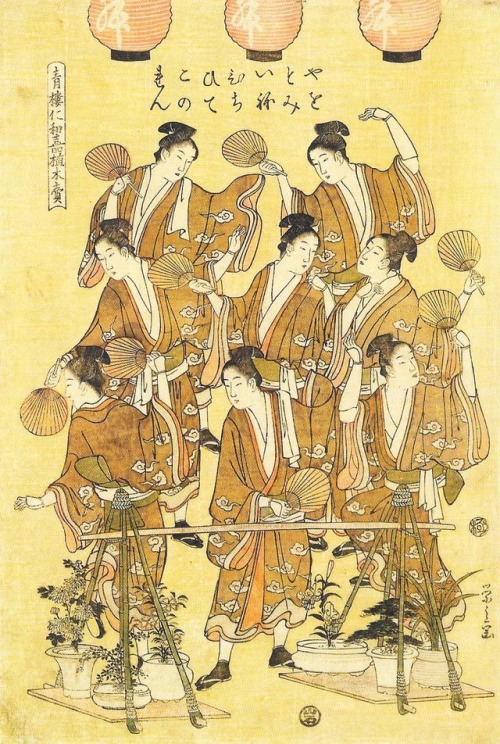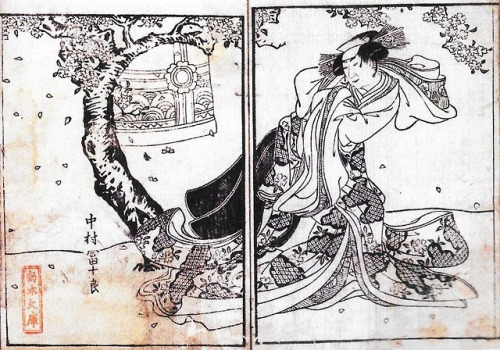#wakashu
Today’s piece of art is a piece of early pop culture and features a troupe of wakashu geisha from the mid-1790′s Edo era Japan in a “boy band” style group picture (1, p. 86) which could serve as either an advertisement for the troupe or as an early “pin up” for their admiring fans, both male and female.
During the Edo era, assigned male children went through three phases of life. As young children, their hair was unshaven. When they became teenagers, they became known as “wakashu” and were identifiable by their shaven forelocks and folded ponytails. (1, p. 19) When they had their coming of age ceremony in their late teens or early twenties (though the age could legally be extended to as late as 25 in the cases of sex workers), (2) the tops of their heads were shaven during their coming of age ceremony making them identifiable as adults, or “yaro”. (Women’s version of this involved blackening their teeth when they married and shaving their eyebrows after giving birth to their first child.) (1, p. 19)
Wakashu were socially prized for their beauty and were considered available for sex with both women and adult men (though not with other wakashu). With women, they would be the penetrating partner during sex, and with men they would (at least in theory according to social norms) be the receptive partner. (1, p. 98), (2)
In this image by Hosoda Eishi entitled “Plant-selling, Yoshiwara Niwaka Dance, (1, p. 86) a troupe of nine wakashu geisha strike appealing poses using their fans as accents as they stand in front of potted plants. Each troupe member is identified by name on the poster. (1, p.86) Wakashu are typically drawn nearly identically to women in Edo art, but there are always several key identifying features to signify the identities of both wakashu and women to the viewer. In this case, the wakashu in the image all have shaven forelocks (the area of the hairline just above the forehead). Though drawn subtly on most of the figures, the shaven forelocks are most evident on the wakashu on the far left of the middle row, and when used for comparison, becomes more obvious on his troupe-mates.
Additionally, the viewer can tell that these are all wakashu because of their folded ponytails, whereas women’s hair at the time featured a large comb that ran from side to side on the crown of the head. That said, it is worth noting that as commonplace as male sex work was in Edo Japan, geishas’ function was to compliment the sex workers around them, and not to have sex with their clients. (1, p. 86) (4)
Geisha first appeared in the 1690′s as skilled male entertainers who would entertain customers as they waited to see the more popular sex workers in the (officially licensed) “pleasure districts”. (3) (These districts were also where kabuki theaters were required to be located due to their close association with prostitution). Female geisha did not appear until the 1750′s and originally dressed as men and shaved their hair like wakashu to imitate their male counterparts and were known as haori geisha (named for the men’s haori jackets they wore). (4) Female geisha were a success, and as they came to dominate the industry, most switched to female attire, though some remained male presenting haori geisha. (4) The geisha profession was considered a female occupation by 1800, though male geisha, such as those in this image whose heyday would have been coming to an end at the time of this illustration, have continued to exist into modern day. (3)
IMAGE SOURCE: Royal Ontario Museum
REFERENCES / FURTHER READING
(1) Mostow, Joshua S. and Asato Ikeda. A Third Gender: Beautiful Youths in Japanese Edo-Period Prints and Paintings (1600-1868). Ontario: Royal Ontario Museum, 2016. Print.
(2) WIKIPEDIA ARTICLE: “Wakashu”
https://en.wikipedia.org/wiki/Wakashū
(3) WIKIPEDIA ARTICLE: “Geisha”
https://en.wikipedia.org/wiki/Geisha
(4) SAMURI-ARCHIVES ARTICLE: “Geisha”
https://wiki.samurai-archives.com/index.php?title=Geisha
HYPERALLERGIC ARTICLE: “The Hidden History of Wakashu, Edo Era Japan’s “Third Gender”
https://hyperallergic.com/367604/the-hidden-history-of-wakashu-edo-era-japans-third-gender/
WIKIPEDIA ARTICLE: “Kabuki”
https://en.wikipedia.org/wiki/Kabuki
WIKIPEDIA ARTICLE: “Kagema”
https://en.wikipedia.org/wiki/Kagema
ISSENDAI ARTICLE: “Kamuro”
www.issendai.com/japanese-courtesans/kamuro.html
WIKIPEDIA ARTICLE: “Onnagata”
https://en.wikipedia.org/wiki/Onnagata
Post link
Today’s piece of gender non-conforming art history comes to us from 1790 Edo era Japan and features an onnagata, a word which loosely translates into “female impersonator [of the kabuki stage]”. (1) Onnagata became a theatrical staple once a law was passed mandating the exclusion of female actors in 1629. (2) Given the need for female characters to tell stories reflecting daily life, onnagata roles became wide spread. Given the sheer numbers, it is difficult to infer anything about the actors who portrayed these roles, but as some actors who specialized in onnagata roles chose to live as women off the stage, as well, (2, p. 28) these roles would likely have been pursued by people who, today, would be regarded as transgender women in the West.
Kabuki theater was originated in 1603 with all female troupes where, inversely, female actors played the male roles. (3) In 1629, the government banned women from the stage in an attempt to stem the widespread practice of their being available for sex work after the show. (3) The actresses were then replaced by wakashu (3) who were young men in their teens or early twenties and had not yet had their coming of age ceremony into adulthood. (4) The wakashu played both characters who were, themselves, wakashu, as well as female roles as onnagata, however, in 1642, the government banned both wakashu and onnagata parts because of the continued practice of the actors being available for sex work after the show. (3)
The government lifted the ban on wakashu theatrical characters in 1644 (as otherwise, during the ban, plays could only depict stories between adult males) and they lifted the ban on onnagata characters in 1652, however, in both cases it was with the caveat that the actors now had to shave the tops of their heads in the same manner that adult men were required to do. (3) The onnagata and theater wakashu then took up the practice of wearing head scarves to cover the shaven bald spot, as can be seen in this image. (3) Onnagata can be identified in art by their head scarves in combination with female hair styles which can be distinguished by the large comb running side to side across the top of the head.
This print is by Ryukosai Jokei from a book of prints entitled “Garden Puddles” and depicts the onnagata actor Nakamura Tomijuro standing in a garden under a blossoming cherry tree. (2, p. 34) Beginning in 1751, nigao-e, which were commercially available paintings or prints of popular actors, became widely available and very popular making Japan the first known place to develop a modern pop culture. Prior to nigao-e prints, which were made both for artistic purposes as well as for commercial advertisement, such art featured general stylized depictions of well known kabuki characters without attempting to portray the individual actors playing the roles. (2, p.34)
For this reason, onnagata in this era were frequently artistically depicted as idealized versions of cisgender women, though the public would have understood that they were onnagata performers, (2, p. 34) both because of their signature head scarves, but also because women were not allowed on the stage. (3) As a part of the trend of depicting individual actors rather than generic renditions of familiar characters, Ryukosai Jokei is thought to be the first artist to portray onnagata explicitly as assigned male actors playing female roles rather than as cisgender women as can be seen in the facial features in this illustration. (2, p. 34)
IMAGE SOURCE: Royal Ontario Museum
REFERENCES / FURTHER READING
(1) WIKIPEDIA ARTICLE: “Onnagata”
https://en.wikipedia.org/wiki/Onnagata
(2) Mostow, Joshua S. and Asato Ikeda. A Third Gender: Beautiful Youths in Japanese Edo-Period Prints and Paintings (1600-1868). Ontario: Royal Ontario Museum, 2016. Print.
(3) WIKIPEDIA ARTICLE: “Kabuki”
https://en.wikipedia.org/wiki/Kabuki
(4) WIKIPEDIA ARTICLE: “Wakashu”
https://en.wikipedia.org/wiki/Wakashū
WIKIPEDIA ARTICLE: “Kagema”
https://en.wikipedia.org/wiki/Kagema
ISSENDAI ARTICLE: “Kaumro”
www.issendai.com/japanese-courtesans/kamuro.html
HYPERALLERGIC ARTICLE: “The Hidden History of Wakashu,; Edo Era Japan’s “Third Gender”
https://hyperallergic.com/367604/the-hidden-history-of-wakashu-edo-era-japans-third-gender/
Post link


